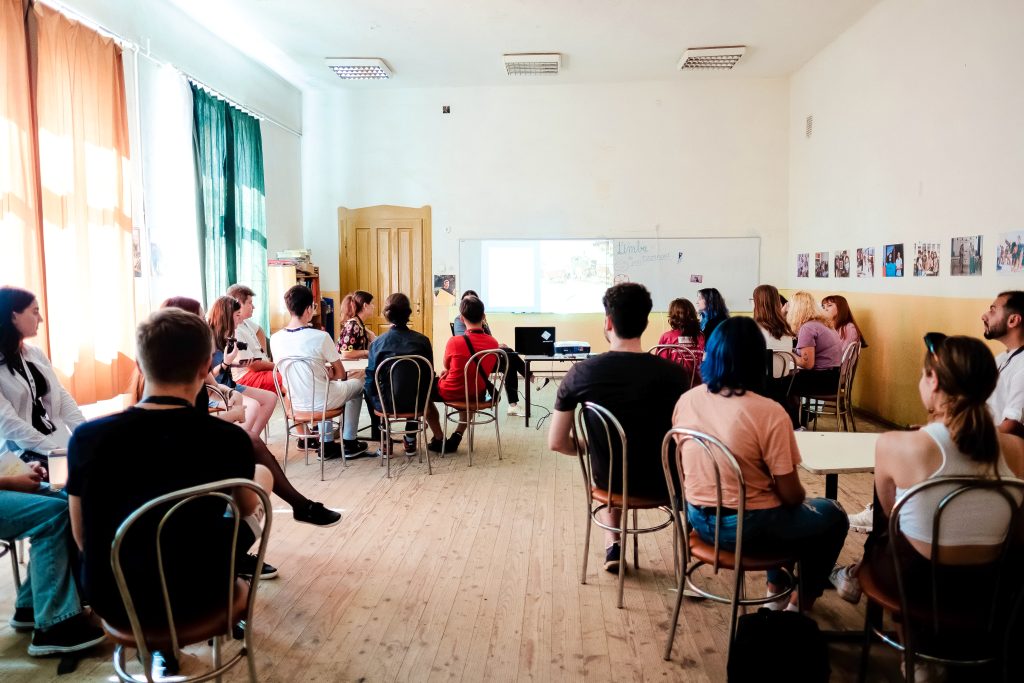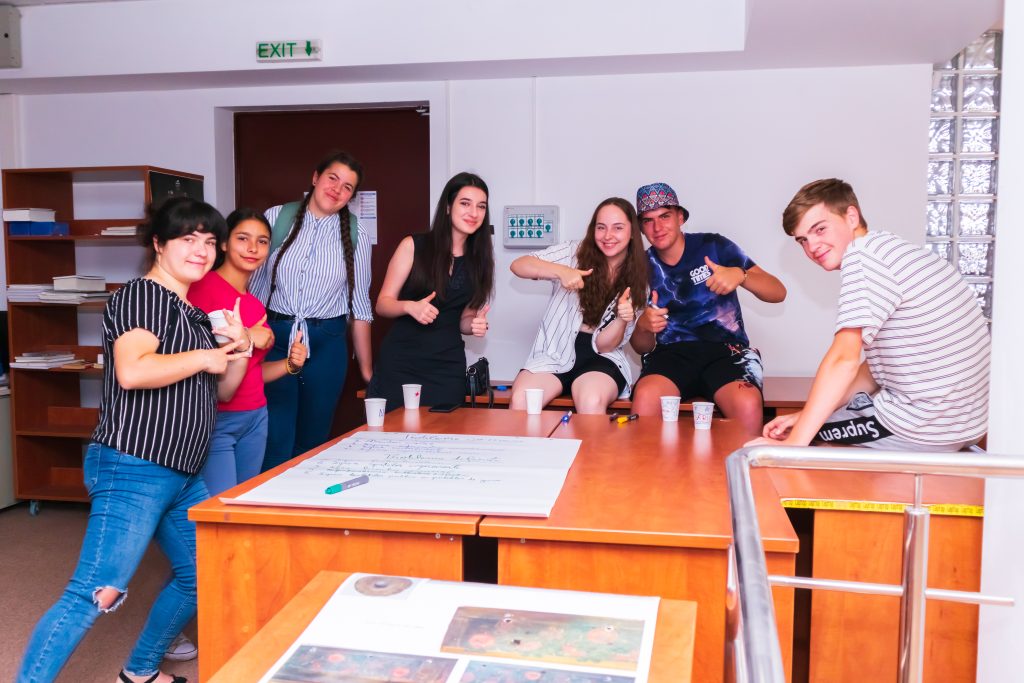
The European Youth Village is a Romanian program focussed on the specific challenges and needs of young people from rural areas. It also tries to create opportunities for rural youth. Europe Goes Local interviewed Victor Toma, the European Youth Village program coordinator and youth worker, to tell us more.

Young people in rural areas face a variety of challenges and difficulties that often go unaddressed by local, national, and European authorities. Existing public policies are inadequate in addressing the needs of rural youth, and the rural youth sector is largely invisible. The lack of dialogue between young people and their communities and authorities results in policies being set without their input.
The European Youth Village program seeks to address this. On the one hand, the programme does this by fostering a dialogue between community members and institutional actors. On the other hand, it empowers young people to take an active role in shaping their future. The program is designed to address the specific challenges and needs of rural youth. It also offers a fresh perspective on the rural youth sector.
Our goal is to create opportunities for young people from rural areas in their villages, to promote the development of the rural youth sector by organizing the young people, and fostering collaborations between the young people and the decision-makers. Meanwhile, we’re also trying to strengthen public youth policies at all levels.

The Governance of the program gives The ‘European Youth Village’ title to villages or rural communities that wish and plan to make real change happen in the youth life. It takes into consideration their local challenges as well as the programme’s main priorities.
The Governance of the programme opens a call each year so young people from rural areas can apply for this title. Young people can apply and plan their village’s application with the support of the local authorities and a non-governmental organization. This way the initiative starts from the young people to the rest of the stakeholders. It aims to reach the highest level of youth participation where young people are the initiators. It takes Roger Hart’s ladder of participation into consideration. Then, the decision is taken together with the decision-makers, who become part of the process, and share and support the young people’s efforts.
The Governance pre-selects the applications. And then the young people from finalist groups are entering a mentoring and training program. It focuses on equipping them with the competencies and tools they need in order to organize a consultation with young people, engage and organize young people, build a relationship with the local decision-makers, and plan their village final application together. Later, a team of professionals from the youth sector at the national level evaluates all the applications. This team decides how many and which rural communities will receive the title.
European Youth Village is coordinated at the national level in a co-management system by ADA (Active Development Association) and Go Free, with the involvement of youth organizations and informal youth groups from the European youth villages network. Along with us, in the network, there are organizations that locally coordinate the program in the villages that have received the European Youth Village title.
One of our aims is to create development opportunities for young people from rural areas in rural areas. Thus, our intervention plan is based on community organizing, community development, advocacy, and education.
The Program’s four pillars are:
We’re helping young people from rural areas to develop, design and implement activities through which they contribute to the personal, professional, and social development of their peers. Meanwhile, we’re also facilitating the intercultural dialogue among youth and empowering young people to actively participate in the decision-making process at all levels.
Most of the existing programs for rural youth in Europe are focused on agriculture and start-ups. Moreover, most of the time, decision-makers lack an intersectional approach to rural youth. And they can’t understand why promoting and supporting rural youth participation is important. When we built the European Youth Village programme our focus was on creating a culture of participation in rural areas, empowering rural youth, and building learning and inclusive opportunities, while promoting an intersectional approach in all local policies and at all levels. This also made our programme innovative.

First, during the year in which the rural communities hold this title, all activities, projects, events, or actions that are organized at the local level aim to increase the participation of the young people and to develop a culture of participation at the local level in order to solve the problems that directly affect them. Young people become more aware of their local resources by participating in the program. They also become more visible and ready to act strategically and to create the change they want in their community.
At the same time, when young people became more visible at the local level, they start assuming an active role in their community. The authorities become more open towards young people and youth work. Moreover, we help young people plan youth projects and apply for funding under Erasmus+ and European Solidarity Corps.
Last but not least, they’re becoming part of a national community that is there for helping and supporting them constantly. They also expand their network of friends, peers, and partners.
Unfortunately, the rural youth sector, at least in Romania, is lacking in visibility, resources, and youth practitioners. In the villages, there are not enough organizations, youth workers, and youth centres. And the youth sector does not represent a priority for the local decision-makers.
Through European Youth Village, we don’t only organize young people in rural areas. We also train them as youth organizers and youth workers. Young people are one of the most important resources that villages have. So we use this resource to transform rural communities, while also developing the rural youth ecosystem. We empower and help young people to take an active role in their communities, develop projects and opportunities for others, to become equal partners to the decision-makers, and to feel that they are part of this ecosystem.

Over time, the program began to mean more than just a title. So the intervention plan expanded to the entire rural youth ecosystem:
The White Charter for Rural Youth is a strategic document. It aims to contribute to the development of young people and the entire rural youth ecosystem. Young people proposed a set of strategic directions that local, county, regional, national, and European public authorities should follow based on research at carried out at the national level.
The strategic directions are the following 10 domains considered relevant by young people:
The White Charter for Rural Youth hasn’t been translated to English yet. But the 10 strategic priorities of the young people from rural areas in Romania are these:
By implementing The White Charter for Rural Youth, we want to make rural youth’s vision come true. We also want to activate, empower, and connect young people in rural areas. We want them to become active citizens in their communities, and equal partners with public authorities and other stakeholders in the local community. Furthermore, we want that young people from rural areas become more visible, more connected, and more involved in the decision-making process in their communities.
We aim to produce positive effects and a sustainable impact in rural communities. We promote human rights and democratic values, we facilitate young people’s access to quality education, local resources, social services, health services, social protection, and development opportunities. Further, we want to transform public institutions in rural areas into inclusive, socially, physically and psychologically safe spaces for all children, young people and adults in the local community, and combat any form of social exclusion and discrimination.
Finally, we want to support the entire rural youth ecosystem. Both by supporting youth organizations and informal youth groups, as well as by developing strategic contexts of involvement, development, and collaboration at the national, European, and international levels.

Other components of the European Youth Village program are:
The Rural Youth Summit is a national event that brings young people from rural areas, decision-makers, and representatives of youth organizations together from all over the country. So far, we’ve organised three successful Rural Youth Summits at a national level in Romanian villages. And we’re excited to announce the first ever European Rural Youth Summit in the summer of 2023.
The Rural Youth Awards is another national event. It aims to make young people from rural areas visible and to recognize their participation in their community. At the same time, it celebrates rural youth work and acknowledges best practices from the rural youth sector.
RITM is an informal network aiming to raise the level of representation of young people from rural areas in the decision-making process at the local, regional, national, and European levels.
The (n)GoRural Platform is a network of organizations and informal groups of young people. It aims to support the rural youth sector and rural youth work.
European Youth Village became one of the biggest rural youth movements in Europe. At the local level, we successfully managed to empower young people and help them create opportunities for their peers. But we were also able to convince decision-makers to start investing in youth.
We have villages where young people managed to convince authorities to build, or transform abandoned buildings, in functional youth centres, to fund the youth sector, and solve other issues that were directly affecting young people. At the same time, young people started being more visible, more empowered, and more interested in rural areas. They bring more resources to their villages. For example, last year, approximately 15% of all solidarity projects approved were submitted by young people that are active in the European Youth Village community.
At the national level, European Youth Village managed to make the rural youth sector more visible and a priority. We placed rural youth and their challenges on the public agenda. European Youth Village serves as a positive model of community organization for rural youth.
It can also be replicated internationally to bring attention to the challenges and needs of rural youth and to create development opportunities for them. Moreover, last year, the EU Commission invited us to Brussels to discuss the extension of the European Youth Village program at the European level.

On this note, together with our strategic partners, the Romanian National Agency for Erasmus+ and European Solidarity Corps, we will organise the European Rural Youth Summit. The event will take place in Panaci village, Suceava County (Romania), between the 29th of August and the 2nd of September 2023. Panaci is one of the villages that this year bears the title together with the the other 4 villages.
The European Rural Youth Summit is organized under the umbrella of the European Youth Village Program. It aims to strategically develop the rural youth ecosystem in Europe by bringing together young people from rural areas across Europe, youth workers, youth organizers, and decision makers. It will also provide a platform for them to raise their voices, and share their experiences and perspectives on rural youth work and rural development.
The event will include a youth-led policy lab where participants will be able to work on policy proposals and recommendations on how to improve the situation of rural youth in Europe. There will also be panel discussions, thematic workshops, and networking opportunities for young people and professionals in the field of rural youth. Furthermore, there will also be cultural activities and opportunities for the participants to get to know each other and to exchange their experiences and cultures. The event will also focus on scaling the European Youth Village program to a European level.
Website: www.europeanyouthvillage.eu
Instagram: European Youth Village (@europeanyouthvillage)
Facebook: European Youth Village